TAPE 79/SI/01
THIS TAPE HAS BEEN RECORDED ON THE 12th of JULY 1979 AT SPRING VALE MILL, HASLINGDEN. THE INFORMANT IS STANLEY GRAHAM.
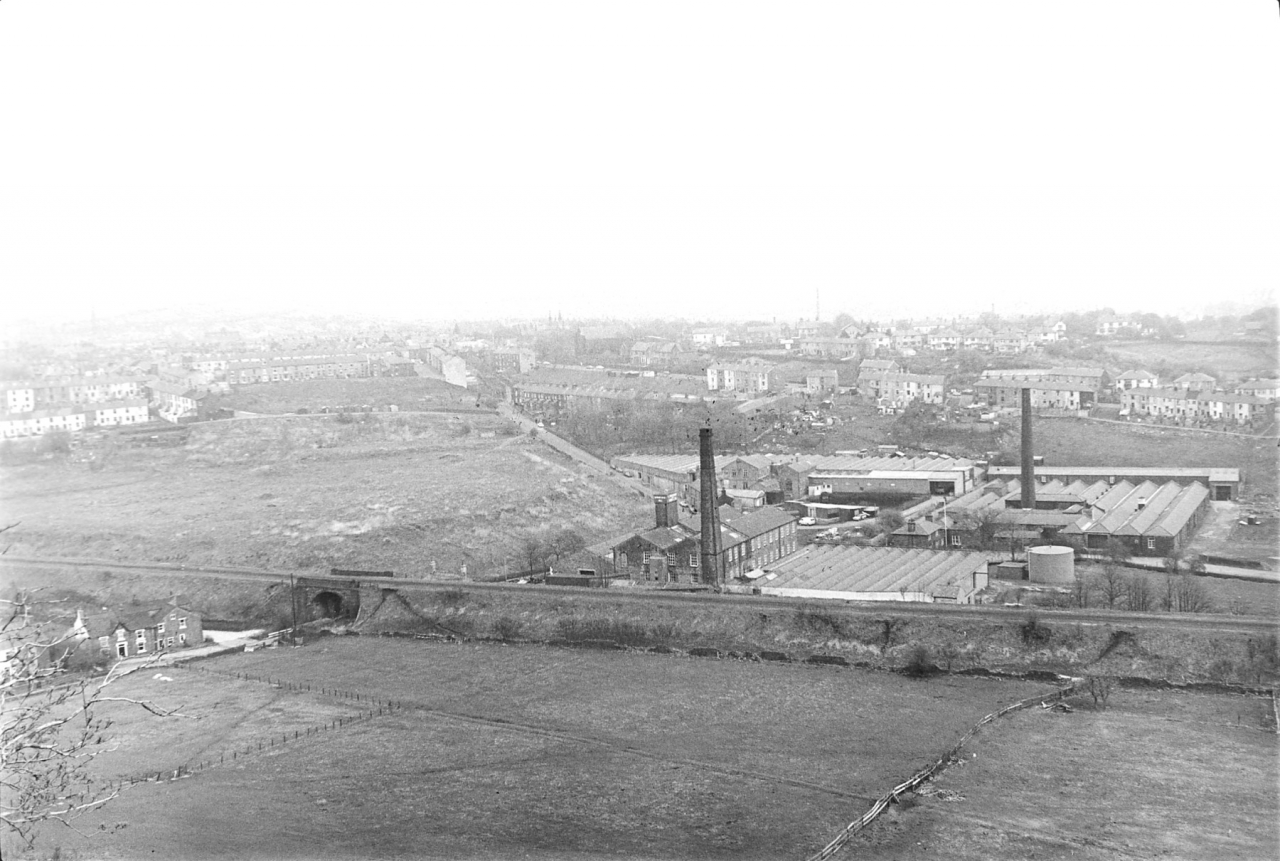
Overall view of Spring Vale Mill at Haslingden in 1979 before the motorway was built along the line of the derelict railway. If you look very carefully at the field on this side of the embankment you will see parallel lines in the ground in line with the railway. These are the traces of the tenterfields that the mill used in the days when they were fulling cloth.
This is Thursday 12th July, 1979 and I'm stood outside Whitaker’s Spring Vale mill at Haslingden. And the purpose of this tape today is to go into one or two of the departments of the mill and get some of the sound effects down for posterity. The things that I’ll be concentrating on will be the devil hole, and the mule spinning. It would be very easy to do a description of somewhere like Spring Vale if you could start at the beginning and go through each lot of machinery which would lead into the next process, which would a nice, tidy result. But unfortunately this doesn't apply. The first place we are going to go into is the devil hole, which is the noise that you might possibly be able to hear in the background, a high pitched whining noise. This is where the devils are at work.
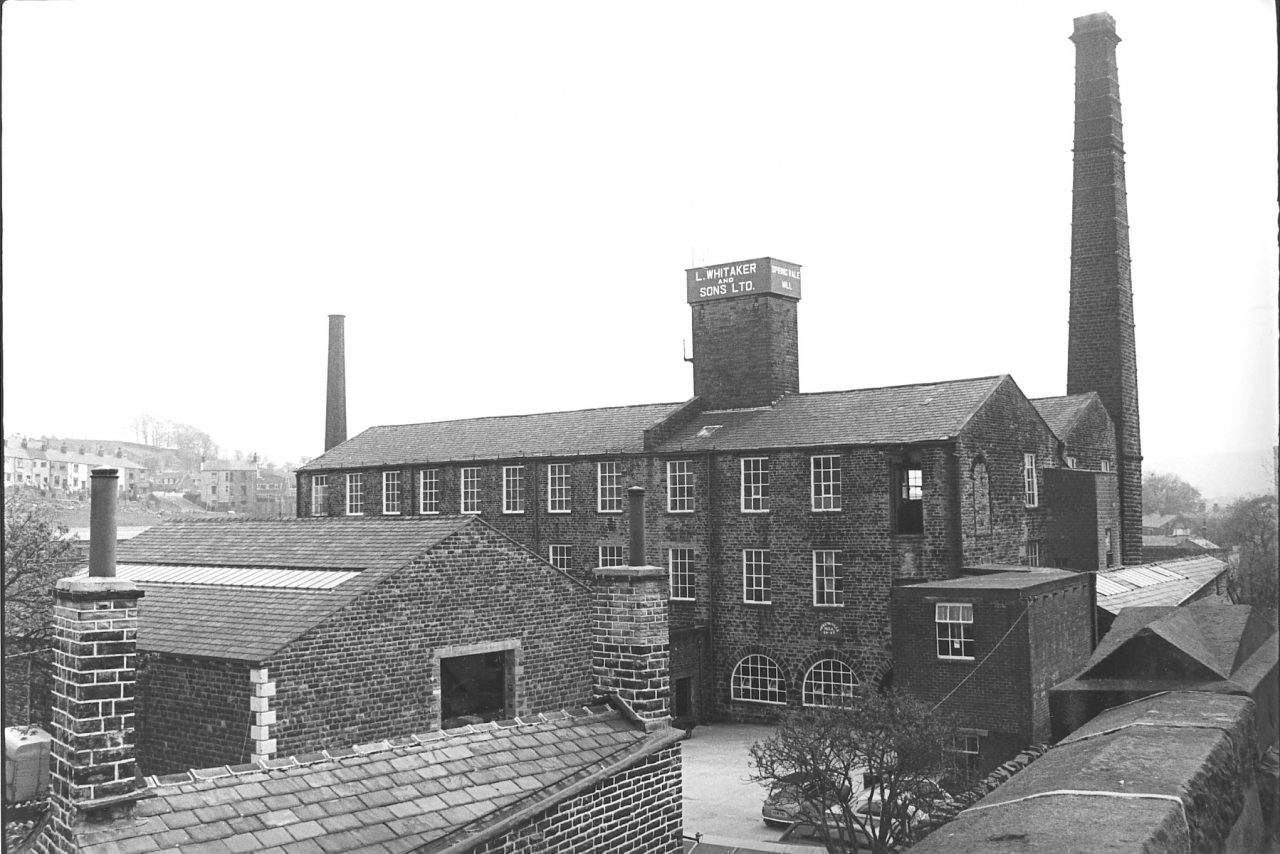
The devil hole is behind the two arch topped windows on the right of the mill. You can see part of the entrance to the right of the windows.
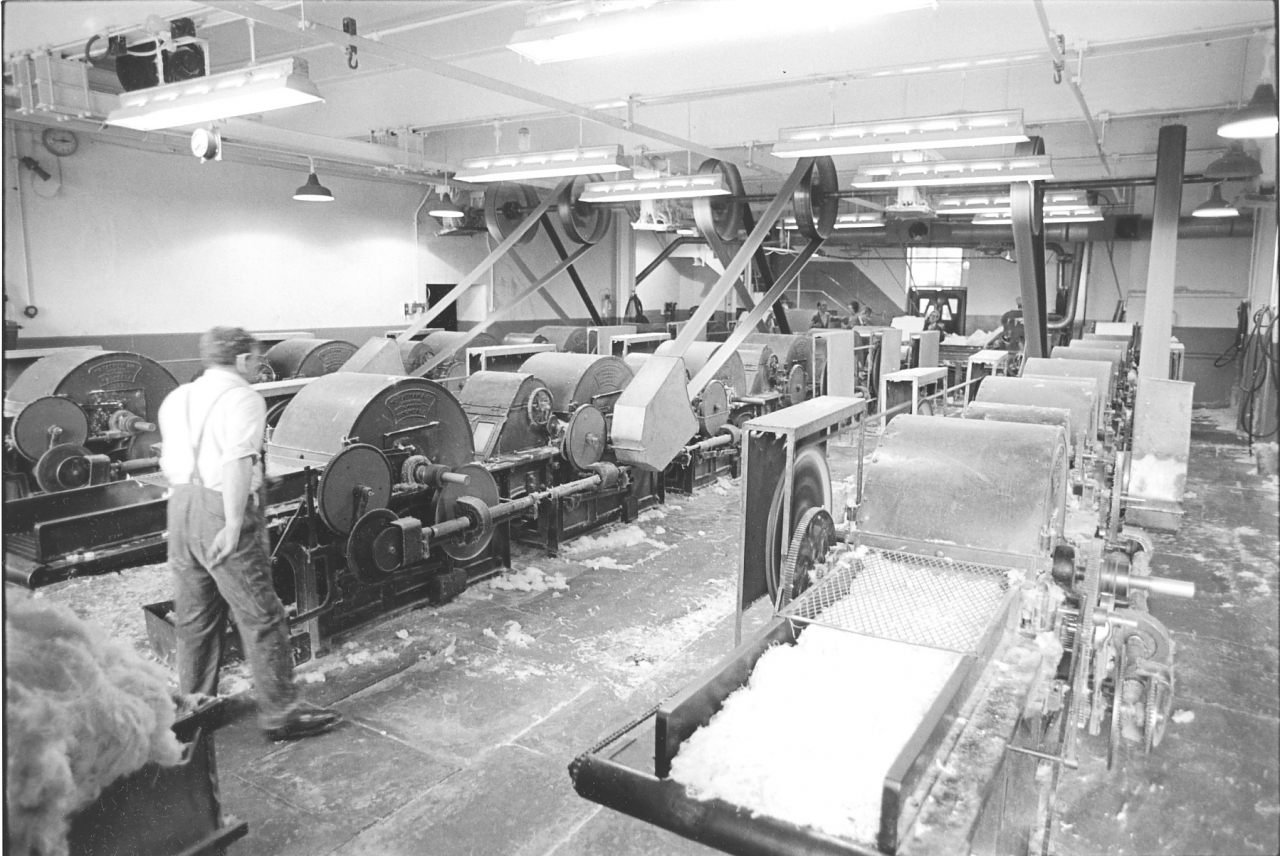
Inside the devil hole.
Now, the devils aren’t the people that run them, these are the machines. A devil is a machine which consists of six rotating cylinders with short spikes on which are breaking up hard waste, cop bottoms and things like that, and reducing them to something which to the layman would look very similar to rough cotton wool. Now not much of this waste is used for spinning at Spring Vale. The cop bottoms and hard waste are broken up here, baled and then sold to other processers. Most of the spinning at Spring Vale is done with softer waste and raw cotton which comes in in bales. So we'll concentrate on the devil hole first. The reason they're called devils is that they have a propensity to catch fire, very fast rotating cylinders, a certain amount of grit about, highly inflammable finely divided cotton fibres. In the photographs of the devil hole you'll notice that there are more than adequate fire points, aid that fire buckets are stationed at frequent intervals between the machines. A fire in a devil hole is not an uncommon occurrence, I know that during the time I’ve been coming to Whitaker’s there has been one hot machine but it was nothing serious and they opened it up and got the smouldering stuff out. It's caused, obviously by friction.
(100)
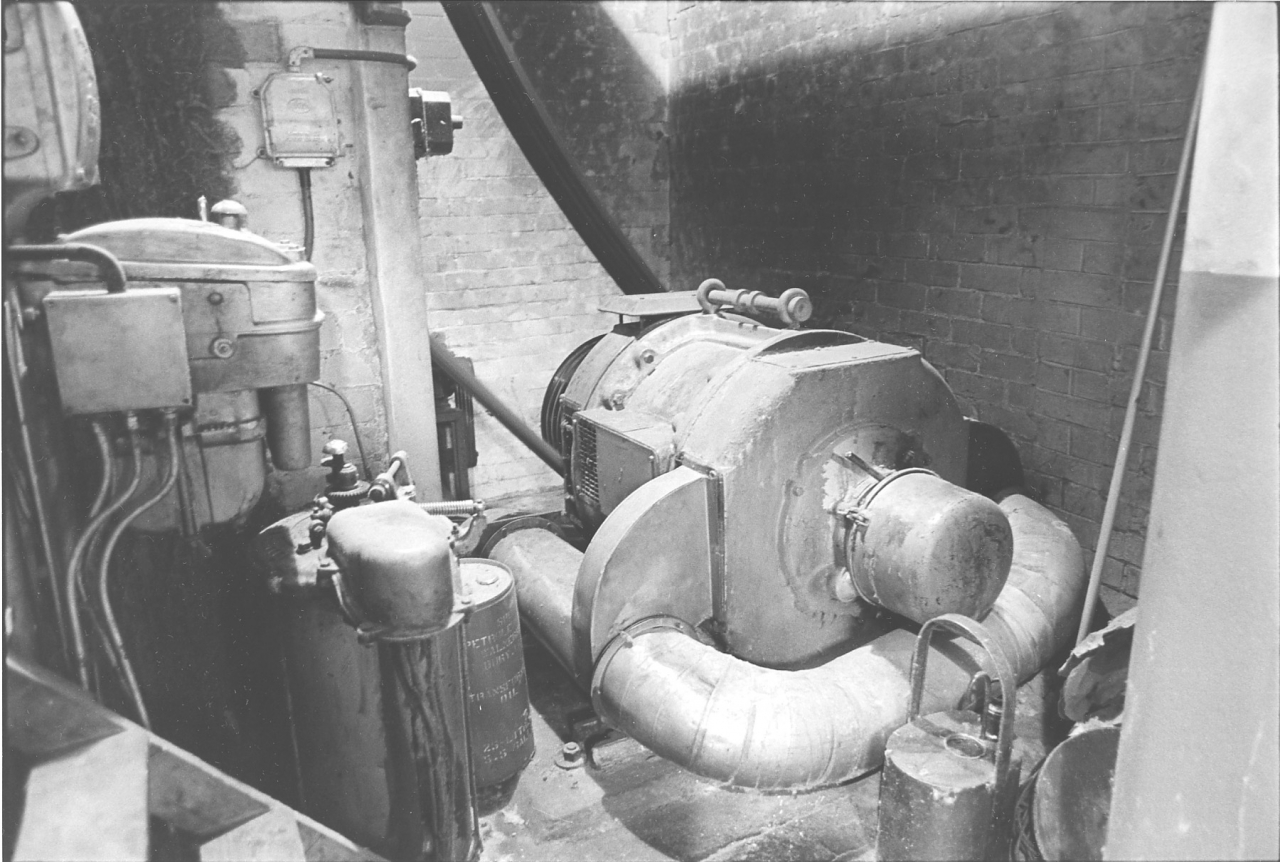
The devils are driven by a very large electric motor, a 140hp motor and all that power is needed, they do soak up some power. At the moment I’m stood outside Spring Vale Mill which was built in 1847 and replaced a water driven fulling which originally stood on this site. This mill is shown on the first edition of the Ordnance Survey six inch map, surveyed about 1845. Interestingly enough the tenting frames are shown on that map, and they extend in a westerly direction from the site of the present mill; and if you go up on the bank and look down, they go underneath the site of the present railway line which runs up the side of the mill but on the other side you
(5 min)
can see some grooves in the land and these lie in the same position that’s indicated on the map as the place where the tenting frames were. It seems to me that they could possibly be the marks that were worn into the floor by the people on the tenting frames. Now what we are doing now is walk across to the devil hole and you'll hear the noise rise as approach it.
(140 ... Sound of devils at work
(179 ... We are inside the devil room now and what you are listening to is the noise of the devils working. It’s very hot, there's a lot of cotton fibre about but there in not really a lot floating about in the air. As I say it's very warm, and you can hear the belt fastenings clicking. All belt driven. Unless you've actually done it it's hard to understand how anybody can work in these conditions all day because the noise is really
(200)
bad. I should say that it's equally as bad as a weaving shed. I’m just going to move round the machines now and I shan't talk for a bit and I’ll just let you listen to these machines working
(215 ... sound of devils at work
(10 min) (315)
Well, here we are outside once more, a bit of sanity. That noise really is quite amazing and the conditions are as well. I should say that the temperature in there is probably something like eighty-five degrees, it is a fairly warm day outside, the outside temperature will be about sixty-five to seventy. Yes, sixty-five, sixty-seven, something like that. And it really is warm in there. The air is full of minute bits of cotton dust floating round. You can't really see them, but if you stay in there very long you'll find that your clothes are covered with it, and your nose starts to itch and your eyes, you have to rub your eyes and your hair gets full of it if you are in for a day. The last sound you heard, you probably noticed before I came out that the sound decreased, that there was a, the sound just
(15 min)
went down a little bit and there was a more, a sweeter, high pitched note. That was the sound of the motor which drives the devil hole as I walked past it. This process breaks up the hard waste, or rather breaks up the waste and reduces it to something very much like cotton wool. This does tend to float about all over the place and for that reason they sweep regularly in there, because obviously the fire risk with finely divided
(350)
cotton like that is absolutely tremendous. I don't know, I haven't enquired into the subject yet but it makes you wonder what the insurance premium is for an operation like that. It must be quite something.
Once the waste has been broken up in there, as I say most of this waste is baled, but normally if they were using that type of waste it would go forward to the mixers or blending machines and the carding machines. From there, having been converted into roving, go to the mules. Now we’ll go and have a look at the hard waste breaker [Jumbo] and see if that's running because really that is a complementary stage to the devil. It's a machine which is used for breaking up very hard waste. Hard cop bottoms and things like that and it’s then mixed with the other sorts of waste to go into the carding machines. The process of preparing cotton for the mule is really basically a process of cleaning, combing and separation. The aim of the exercise is to get all the fibres laid in the same direction, separated and free from any extraneous dirt.
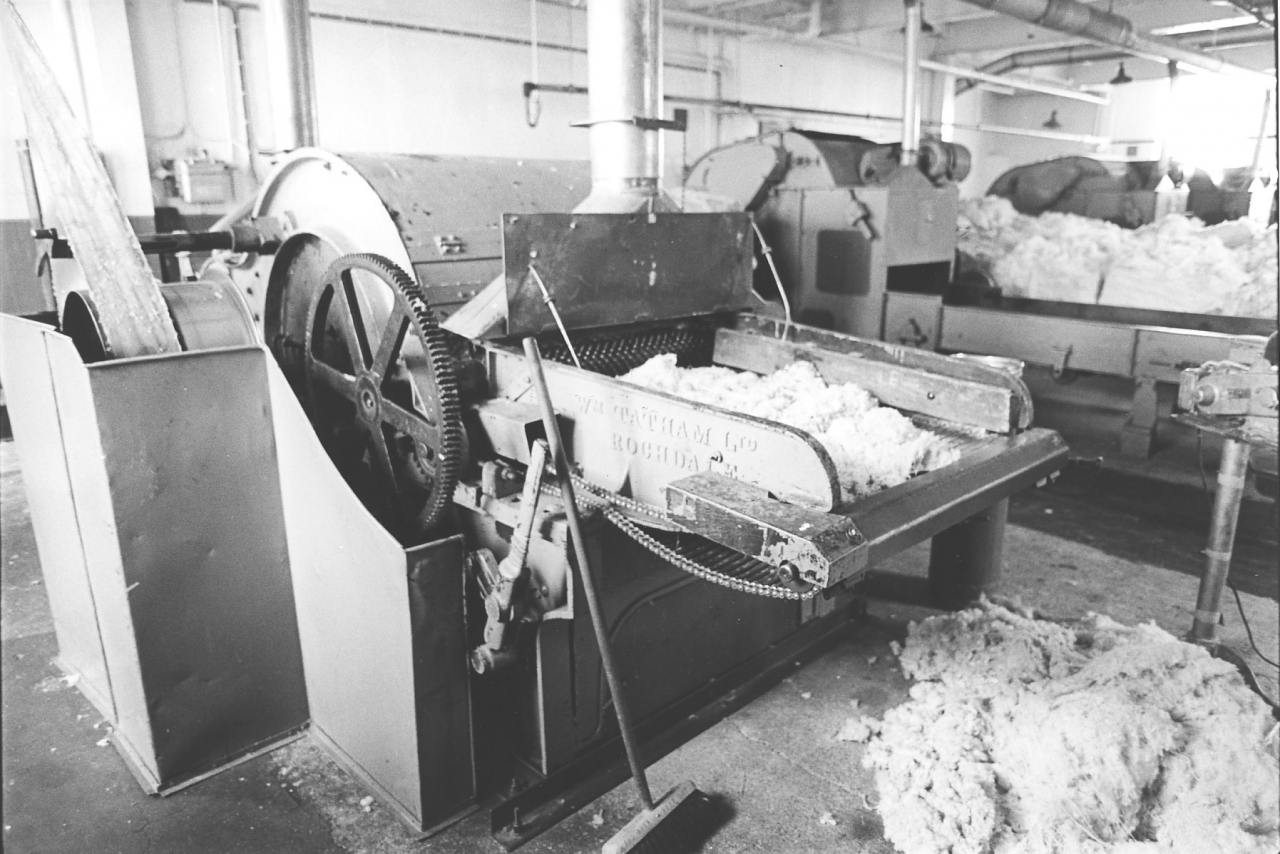
The 'Jumbo' hard waste breaking machine.
The scutcher.
It's quite obvious that somebody must have known I was going to try and do this tape today because neither the hard waste breaking machine or the blenders are working. So what we'll do is go in, and have a look or rather a listen, to the next process which is the scutcher. From the scutcher it goes forward to the cards where it is made into roving, doubled, then made into fine roving for the mules. So the first thing we'll go and look at are the scutchers working. We are in a corner of the scutching room now and the noise you can probably hear in the background is the sound of the scutchers at work. Now, what they are doing is they are feeding bales of cotton waste which has already been broken up on something like a devil or the hard waste breaking machine. And it converts it into a mat or long wide ribbon, about three feet wide, and about three inches thick, of cotton wool which is rolled on to a roller and these packages are taken forward into the carding room to feed the cards. It progresses through different processes in the carding roomy until eventually a very fine roving which is suitable for use on the mules, the spinning machines. Now I’ll walk down, round the scutcher now, you’ll get an idea of some of the noises here.
(20 min)
(430. sound of the scutchers at work.)
(485)
Once again a fairly noisy process but nowhere near as bad as the devil hole. I've walked through now and I’m in the card room. Now these machines don't really make a lot of noise, but there are a lot of them. Once again it’s warm, but nowhere near as hot as it was in the devil hole. There are humidifiers in this roomy and it's kept very clean, nicely painted out, the topping’s well swept down and all the machines are well swept up. Once again of course the main reason for that being the great danger from fire. As a matter of fact I’m stood next to four fire buckets.
(500)
Fire points, hoses, extinguishers and buckets are very much in evidence in this mill. The cards themselves are really very simple, a large cylinder, or in some parts of Lancashire, a swift, rotating in one direction and covered with short steel spikes. The cotton is fed through onto this cylinder, and as it passes round it it's torn by other smaller cylinders on the periphery moving in the opposite direction. There are basically two sorts of cards in here. The first type takes the roll of, or lap, of cotton from the scutcher, and delivers it by mean of another spiked cylinder on to a comb which brings it up in a very thin fine sheet
(25 min)
which is condensed into a rope of cotton fibre, which is laid in the can.
These tall cans are then taken down to the Derby doubling machine where about sixty of these slivers are fed on to one roll.
This evens out the mat of cotton. The rolls from that machine are then taken and placed on other cards which convert them into roving. Now these cards divide the mat up as it comes off the cylinder, and rub it between two sheets of composition, it’s sort of half may between rubber and leather and produces the fine roving which is suitable for putting straight on to the spinning machines.
Condenser cards.
I’m just going to walk round the card room and let you listen to some of the noises which these machines make. The noise level is fairly high, but not as high as in the devil hole, and not as high as a weaving shed.
(554 ... sound of cards at work).
(559)
The cards I’m stood next to at the moment are the ones which are turning the lap which comes from the scutcher into a sliver which can go on to the doubling machine. This is the comb working on the cylinder. I walk down now through the carding room and out into the relative quiet of the warehouse at the other side. The noise you can hear in the background now is the noise of the delivery ends of the cards which are converting the lap into roving for the spinning machines. The noise is caused by the eccentrics which are oscillating the two broad belts on the delivery side of the machines through which the roving passes. This tends to roll it and compress it into a very fine, or relatively fine roving suitable for drawing out on the mule spinners, mule frames.
(600 sound of cards at work).
(625)
Right, the stage we've got to now is a long metal bobbin approximately three feet long and nine inches in diameter full of individual strands of roving, probably about thirty strands to each bobbin, which will go on to the mule spinning machine to be spun into weft. So we’ll go upstairs now, and listen to the mules at work. I’m climbing the stairs now to the second floor of the mill, to the mule room that Jim Riley works in. Navy there are mules working on the ground
(650)
floor, the first floor and the second floor of this mill but it seems only right to record the mules that the mule spinner works on who is the subject of the photographs. Up at the second floor now and just going into the mule spinning room.
(658 sound of condenser mules at work)
(678)
A condenser mule.
This is the sound of the condenser mules at work. I must admit to being absolutely fascinated by this process. Anyone that’s got an interest at all in the textile industry or indeed in the story of the industrial revolution and the factory systems must realise that the mules were perhaps the first really sophisticated production machines. The particular mules that we are listening to now were built by Taylor Lang and Company at Stalybridge in 1905 and are condenser mules. The process of condenser mule spinning is that a bobbin containing roving, about thirty strands of roving on each bobbin, are placed on the back of a machine. They are passed through a set of rollers and from there go forward to the
(700)
spindles of the machine. The spindles are on a carriage which holds in this case about five hundred spindles, which are approximately fifty feet wide. This carriage moves in and out, goes in towards the rollers and then out into the wheelgate. A wheelgate is the space in between two sets of opposing mules which are run by two spinners. They don't just run one set each, they run both sets between them and help each other. The process by which the roving is converted into a finer, more tightly spun thread is that the carriage moves out in what is known as the draw, and at the same time the rollers rotate and a certain amount of roving is allowed through and as the carriage moves back it's stretched and twisted at the same time. When the carriage reaches the furthest point away from the headstock, not the headstock, I’m sorry, from the stationary part of the frame where the bobbins of roving and the rollers are it stops and the spindles spin round very quickly, and put an extra twist into the threads. Then the carriage moves back in, and the spindles rotate again but more slowly and take up the thread which has been spun on the draw. This process is repeated over and over again until the spindles are full when they are doffed. That is the full spindles are taken off the machine and empty spindles put on. Obviously this is a very simplified description of the process. And what I’m going to do for the rest of this tapes is to let you listen to the mules actually running and just for the first couple of minutes I’ll describe what the noises are that you're hearing.
The carriage's moving back in now, moving out slowly on the draw and you hear the whirring noise of the spindles. Now the carriage moves back in again, out again…. On the draw….. It's back in again. And we'll let the rest of this tape run with the sounds of the mules working. The squealing noise you hear occasionally, there, just then, it's the belt slipping on the pulley as the spin starts, the twist starts, and the pulley moves over, the belt moves over on to a different speed pulley.
(760 .. sound of mules at work.)
(45 min)(872)
Well, there we are. That’s just a selection of the noises or sounds shall we call them, that can be heard down at Spring Vale Mill, at Haslingden in 1979. There seems every prospect that the mules will keep running for some considerable time yet because even in this technological age no better way has been found of spinning the types of yarn which are being produced here. These mules at the moment are turning out sevens twist, mostly for use in Whitaker’s own weaving shed on Northrop looms. I must admit myself that I could stand and watch these machines working all day, there’s something very romantic about it, it’s also bloody hard work.
SCG/11 June 2003
2,746 words.
